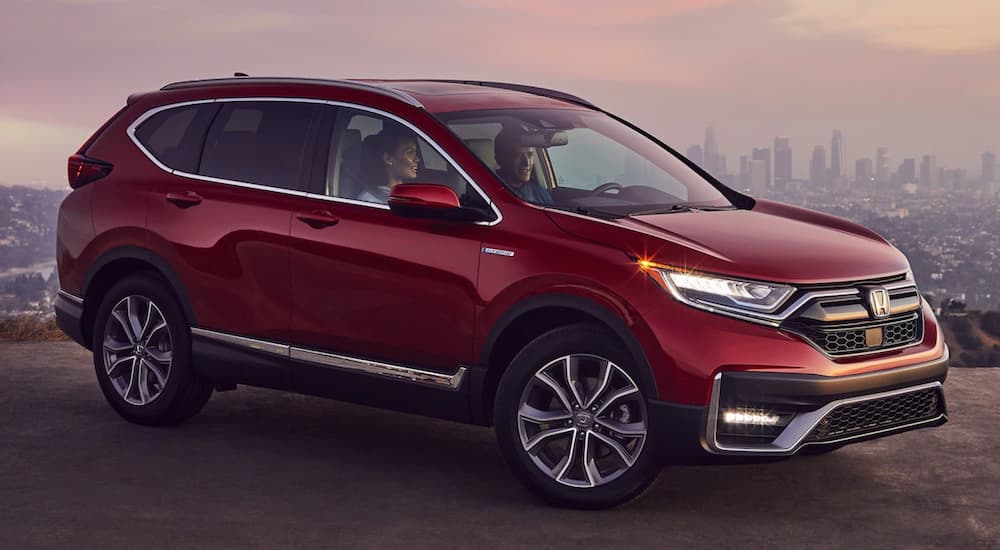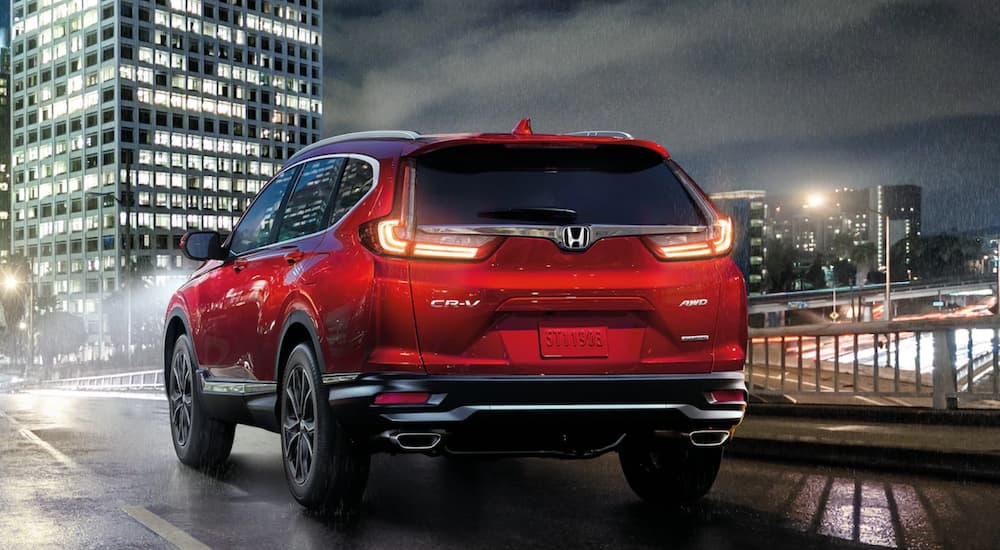A quick visit to your Honda CR-V dealership, and you’ll see firsthand why the CR-V is one of Honda’s best sellers. For starters, the CR-V is one of the most efficient crossovers on the market, with the 2021 model averaging 28 MPG in the city and 34 MPG on the highway. This efficiency doesn’t come at the cost of power, with the CR-V Hybrid delivering 212 horsepower and 232 lb-ft of torque and the gas-powered CR-V producing 190 horsepower and 179 lb-ft of torque.
This power and capability is only the beginning of what the CR-V has to offer. Since its debut in 1997, the CR-V has set a new standard of performance, efficiency, and luxury for the segment and expanded on Honda’s already stellar reputation for producing remarkable vehicles. As we look at the CR-V’s rich history across six generations, you can see its evolution from its debut in 1997 to the 2021 model that offers a new level of innovation we only dreamt about two decades ago. Here’s how the CR-V changed the American automotive landscape for the better.
First Generation (1997-2001)
There wasn’t a name for the compact crossover in the mid-1990s, and that left Honda to create a name of its own for its newly designed vehicle. The Honda CR-V, which stands for Comfortable Runabout Vehicle, made its debut in 1995 but didn’t make it to American roads until 1997, when it became one of the first vehicles to blend the best features of a sedan and an SUV. This debut model shared a lot with Honda’s best-selling Civic but was designed as a mini-SUV complete with an externally mounted spare tire hanging on the tailgate.
The 1997 CR-V was only available in the LX trim, but Honda extended the lineup to include the more luxurious EX, which added anti-lock brakes, aluminum wheels, and an all-wheel-drive option. Believe it or not, these models also came with a table under the cargo floor as well as flat-folding rear seats to maximize the interior cabin when hauling groceries, luggage, and other gear (like chairs to make that table even more practical). All joking aside, the first-generation CR-V continued to see improvements with the addition of leather seating, a combination CD and cassette player, navigation center, and chrome accents to usher it into the new millennium.
Second Generation (2002-2006)
Honda took the best components of the first-generation CR-V and made them even better with the debut of the second generation in 2002. Still based on the Civic platform, the second-generation CR-V boasts even more power, functionality, interior room, and innovation than its predecessor and leads the new segment of compact crossovers in capability and versatility. This stems from a noticeable improvement to the CR-V’s powertrain with the addition of the new 2.4-liter four-cylinder engine that can be paired with either an automatic or manual transmission to deliver 160 horsepower and 162 lb-ft of torque. This increase in power makes a huge difference in the second-generation CR-V since it’s not only quicker to accelerate, but it’s easier to handle in a variety of conditions.
Inside, the second-generation CR-V sees several improvements, including front and rear side airbags for enhanced safety. The rear seat now reclines, and there’s a center console tray in the front for conveniently storing smaller items. The model still comes with a table, but this addition will be discontinued by the 2007 redesign that ushers in a new suite of technology features.
Third Generation (2007-2011)
Honda’s third-generation CR-V sparked controversy when the automaker moved the spare tire from the rear tailgate to under the floor to give the crossover a more upscale and distinctive design. In addition to this change, Honda boosted the power of the 2.4-liter engine to deliver 166 horsepower, an increase of 10 horsepower from the previous year. The automaker also eliminates the manual transmission and makes the 5-speed automatic transmission standard on every trim.
The CR-V’s interior sees several improvements, including wider armrests to improve comfort, added side curtain and passenger-side airbags for enhanced safety, and new premium upholstery. Honda also moved the audio controls to give the driver and passenger easier access in the center dash, which is a welcome addition since the EX-L trim adds exclusive technology features like a six-disc CD player, Bluetooth capability, navigation system with voice activation, and USB input.
Fourth Generation (2012-2016)
The fourth-generation CR-V continues the trend of offering the latest in innovation and the best performance in the crossover segment. Once again, the 2.4-liter engine sees a boost in power to 185 horsepower and 163 lb-ft of torque with the addition of a new continuously variable transmission to the 2015 model. The 2015 model also marks the debut of the Honda Sensing suite of safety and driver-assist tools that includes Adaptive Cruise Control, Lane Keeping Assist, Honda LaneWatch, Forward Collision Warning, and a Collision Mitigation Braking System.
Aside from improved safety and power, the fourth-generation Honda offers plenty in terms of technology, comfort, and entertainment. You can add a power tailgate, LED daytime running lights, and a 10-way power and heated driver’s seat with memory, as well as a rear-seat DVD player that keeps passengers in the backseat entertained. You’ll also find a 5.0-inch center display that offers a variety of tools like Bluetooth, navigation, and a standard backup camera. You can even control the volume and other features using the controls mounted on the steering wheel, which means you can keep your focus on the road and your hands on the wheel.
Fifth Generation (2017-2020)
The 2017 Honda CR-V marks the debut of its fifth generation and the continuation of its reign as the best-selling SUV in America. Honda completely redesigned the CR-V to give it a more aggressive appearance with sharper lines and headlights, a longer hood and wheelbase, and new dual exhaust outlets. This new design makes the CR-V bigger than ever, with its longer wheelbase increasing its interior volume to deliver a more comfortable ride for both the driver and passengers. Of course, conveniences like the 60-40 split-folding rear seat and the hands-free power tailgate add to the CR-V’s functionality and ease of use.
This generation also ushers in a new powertrain with Honda equipping the CR-V with its first-ever 1.5-liter turbocharged four-cylinder engine that delivers 190 horsepower and 179 lb-ft of torque that’s paired with Honda’s proven continuously variable transmission with G-Shift control logic. The CR-V’s interior is also vastly improved to deliver more luxury and sophistication than ever before. This is courtesy of higher-quality materials as well as new technology like the color driver information interface, the display audio system, and smartphone integration. Of course, this generation also sees the addition of the CR-V Hybrid to the lineup, and that alone is a reflection of Honda’s dedication to making hybrid vehicles affordable and attainable to all.
The CR-V’s Impact
Looking at the 2021 CR-V lineup of gas-powered and hybrid trims, it’s hard to believe that the CR-V got its start in the late 1990s with one available trim and a portable table stowed under the cargo floor. The current generation of CR-Vs offers technology we didn’t dare dream of in the late 1990s when the compact crossover segment didn’t even have a name. It’s undeniable that Honda’s Comfortable Runabout Vehicle shaped the segment, and in turn, drivers continue to reap the benefits of Honda’s innovation as they get behind the wheel of the best-selling crossover in America.






